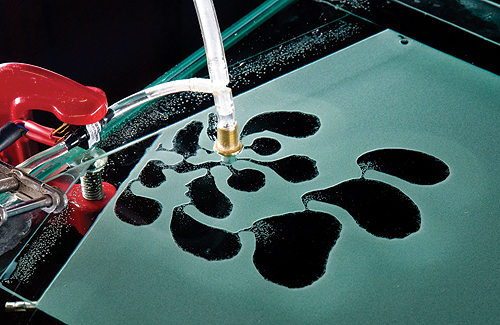Discover new patterns in the movement of granular mixtures
Researchers at the University of Sydney, Australia have discovered new patterns in the movement of granular mixtures, the researchers hope the discovery could help in oil recovery and isolation studies. CO2 in the ground.

The results of this study were published in Nature Communications, published April 20, 2011, by Dr. Bjornar Sandnes, team leader, The results of this study answered the 'Article What happens when you inject air into a mixture of sand and water. ' This will create beautiful images unexpectedly.
Dr. Sandnes has conducted many experiments, through which tiny grains of sand are stuffed between the two poles and injected with air, causing them to move. Dr. Sandnes continues to change: the amount of air injected and the material density in the granular mixture, to create new patterns, never observed before.
Low-density particle mixtures will work with the capital friction produced by low-to-moderate injection of air, creating a sticky bubble, before turning into a motion of the mixture seeds, to finally create new patterns.
"The interaction of single particles when they get together is extremely important in this study," Dr. Sandnes said. "If you push a particle, the effect spreads through the network of particles, or " chain forces , "in the data we collect later. See how simple, repetitive interactions can lead to complex movements on a larger scale.
Dr. Sandnes said: It is the change of injected air flow that has applied friction force to the granular mixture, creating new patterns. This interaction can, for example, be due to increased friction forces, making matter "block" . When this happens, air pressure must be boosted to restart the flow of granular mixture, leading to repeated expansion of large bubbles in the granular mixture. Strictly packed grains, required to be placed in high-pressure environments with air through them, because the passing air will shape the sudden movement of grain grains. . Other experiments such as "friction fingers" and " corals " also create a variety of other moving structures.
"Replace the simple components used in this study, by providing a recipe for studying a range of related processes: to recover oil and gas, isolate and bury CO2. in the ground, and the processing industry for dough, cement, and particulate matter , "said Dr. Sandnes.
"While our job is to develop an understanding of physics, and the implications for the processing industry, but certainly, you can't help but be amazed at the radiant beauty of the pictures. drawing art created by chance by us "
Dr. Sandnes is a lecturer of lectures at the Faculty of Engineering and Information Technology, University of Sydney, Australia. Co-author of the study with Dr. Sandnes, is his colleague, working at the University of Sydney and the University of Oslo, Norway.
- Fishermen catch big fish with mysterious patterns on fish
- 'New weapon' to decode DNA patterns
- Method of filtering styrene pollutants in water
- Discover the mystery in the sun
- Laser beams help discover hidden diseases through breathing patterns
- Discover the magic beauty of sea corals
- Nicolas Copernic (1473 - 1543) Genius theorist: Nhat Tam Universe theory
- If you own a fingerprint of this type, you are born with a rare talent
- Bauhaus pioneer history movement
- Discovered genes controlling colors and patterns on butterfly wings
- Method of finding objects falling on the sea surface
- LG laptop uses fuel cell and OLED screen
 'Fine laughs' - Scary and painful torture in ancient times
'Fine laughs' - Scary and painful torture in ancient times The sequence of numbers 142857 of the Egyptian pyramids is known as the strangest number in the world - Why?
The sequence of numbers 142857 of the Egyptian pyramids is known as the strangest number in the world - Why? History of the iron
History of the iron What is alum?
What is alum?